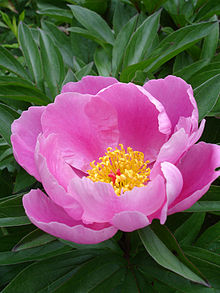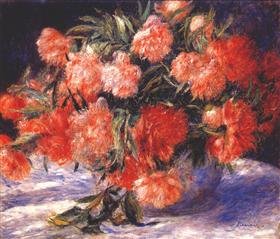
Geranium is a genus of 422 species of annual, biennial, and perennial plants that are commonly known as geraniums or cranesbills. They are found throughout the temperate regions of the world and the mountains of the tropics, but mostly in the eastern part of the Mediterranean region.

Deutzia is a genus of about 60 species of flowering plants in the family Hydrangeaceae, native to eastern and central Asia, and Central America and also Europe. By far the highest species diversity is in China, where 50 species occur.

The peony or paeony is a flowering plant in the genus Paeonia, the only genus in the family Paeoniaceae. Peonies are native to Asia, Europe and Western North America. Scientists differ on the number of species that can be distinguished, ranging from 25 to 40, although the current consensus is 33 known species. The relationships between the species need to be further clarified.

Hibiscus syriacus is a species of flowering plant in the mallow family, Malvaceae. It is native to south-central and southeast China, but widely introduced elsewhere, including much of Asia. It was given the epithet syriacus because it had been collected from gardens in Syria. Common names include the rose of Sharon,, Syrian ketmia, shrub althea, and rose mallow. It is the national flower of South Korea and is mentioned in the South Korean national anthem.

Impatiens walleriana, also known as busy Lizzie, balsam, sultana, or simply impatiens, is a species of the genus Impatiens, native to eastern Africa from Kenya to Mozambique. The Latin specific epithet walleriana honours a British missionary, Horace Waller (1833–1896).

Hyacinthus orientalis, the common hyacinth, garden hyacinth or Dutch hyacinth, is a species of flowering plant in the family Asparagaceae, subfamily Scilloidiae, native to southwestern Asia, southern and central Turkey, northwestern Syria, Lebanon and northern Israel. It was introduced to Europe in the 16th century. It is widely cultivated everywhere in the temperate world for its strongly fragrant flowers which appear exceptionally early in the season, and frequently forced to flower at Christmas time.
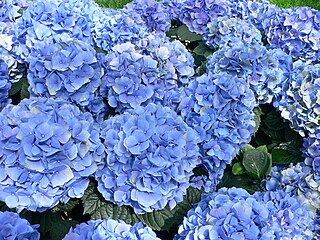
Hydrangea macrophylla is a species of flowering plant in the family Hydrangeaceae, native to Japan. It is a deciduous shrub growing to 2 m (7 ft) tall by 2.5 m (8 ft) broad with large heads of pink or blue flowers in summer and autumn. Common names include bigleaf hydrangea, French hydrangea, lacecap hydrangea, mophead hydrangea, penny mac and hortensia. It is widely cultivated in many parts of the world in many climates. It is not to be confused with H. aspera 'Macrophylla'.

Paeonia daurica subsp. mlokosewitschii, the golden peony or Caucasian peony, is a species of flowering plant native to the Caucasus Mountains in Azerbaijan, Georgia, and Dagestan, where it grows on rocky slopes in oak, hornbeam, or beech forests. The plant is sometimes nicknamed Molly the witch, a humorous mispronunciation of the species name, which most people find difficult to pronounce. It was formerly regarded as a separate species, Paeonia mlokosewitschii, but in 2002, the Chinese botanist Hong Deyuan reduced it to a subspecies of Paeonia daurica.
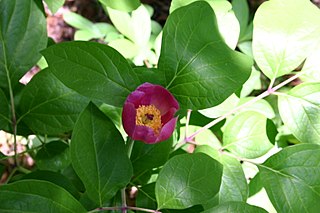
Paeonia obovata is a perennial herbaceous species of peony growing 30–70 cm high. It has white, pink or purple-red flowers and its lower leaves consist of no more than nine leaflets or segments. In English it is sometimes called woodland peony. It grows naturally in warm-temperate to cold China, including Manchuria, and in Korea, Japan, Far Eastern Russia and on Sakhalin.
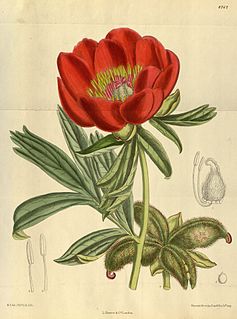
Paeonia peregrina is a species of flowering plant in the peony family Paeoniaceae, native to Southeastern Europe and Turkey. It is an erect, herbaceous perennial with 9-lobed, deeply divided leaves. Single, glossy red flowers, 10–13 cm (4–5 in) in diameter, with prominent yellow stamens, are borne in spring.
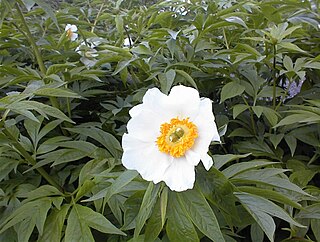
Paeonia emodi is a robust herbaceous perennial plant that winters with buds underground, has large white flowers and large deeply incised leaves, and belongs to the family Paeoniaceae. Its local vernacular names include mamekhor or mamekh (Punjabi), ood-e-saleeb (Urdu) meaning "with-a-cross", ood salap (Hindi), mid and 多花芍药 meaning "multi-flower peony". In English it is sometimes called Himalayan peony. It is among the tallest of the herbaceous peony species, and, while cold-hardy, it grows better in warm temperate climates. It is a parent of the popular hybrid 'White Innocence', which reaches 1½ m.

Paeonia officinalis, the common peony, or garden peony, is a species of flowering plant in the family Paeoniaceae, native to mainly mountainous areas of Southern Europe and introduced in Central and Western Europe and North America.

Paeonia delavayi is a low woody shrub belonging to the peonies, that is endemic to China. The vernacular name in China is 滇牡丹, which means "Yunnan peony". In English it is sometimes called Delavay's tree peony. It mostly has red brown to yellow, nodding flowers from mid May to mid June. The light green, delicate looking deciduous leaves consist of many segments, and are alternately arranged on new growth.

Paeonia × suffruticosa is a name used for a group of cultivars of tree peonies that are the result of hybridisation with species exclusively belonging to the subsection Vaginatae. The common name used in China is mǔdān. Plants belonging to this group have been cultivated for millennia in China, initially only as a source of traditional Chinese medicine particularly the skin of its roots. Already early on the plant was also cultivated for its ornamental value, and it is highly revered in Chinese culture.
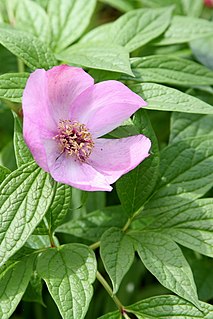
Paeonia mairei is a species of peony, that is endemic to the mountains of central China. Its vernacular name in China is 美丽芍药 meaning "beautiful peony". The plant may be between 45 and 100 cm high and has mostly rose-pink flowers of about 10 cm across, one on each stem. P. mairei blooms in early spring.
Paeonia sterniana is a perennial, herbaceous peony of approximately 45 cm high in cultivation, with white or sometimes pinkish flowers. It grows in the wild in southeastern Tibet. This peony is very rare in cultivation. It produces blue seeds in autumn. Its common name in Chinese is 白花芍药, which means "white peony".

Paeonia tenuifolia is a herbaceous species of peony that is sometimes called the fern leaf peony. It is native to the Caucasus Mountains of Russia and the Black Sea coast of Ukraine, spreading westward into Bulgaria, Romania and Serbia and eastward to northwestern Kazakhstan. It was described by Linnaeus in 1759. The leaves are finely divided into almost thread-like segments and grow close together on the stems. This peony can reach 30–60 cm (12–24 in) in height. The scented red flowers have numerous yellow stamens in the centre.
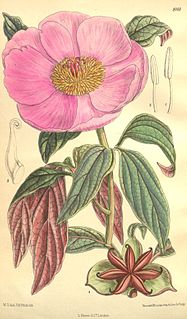
Paeonia cambessedesii is a perennial herbaceous species of peony about 45 cm high. It has pink flowers. The stems, major veins and undersides of the leaves remain purple red, while the upper surface of the leaves turns into a metallic bluish green when fully grown and its lower leaves consist of no more than nine leaflets or segments. This endemic of the Balearic Islands is now limited to parts of northeastern and northwestern Majorca. In English it is sometimes called Balearic peony or Majorcan peony.

Paeonia anomala is a species of herbaceous perennial peony. This plant is ½-1 m high, with a thick irregular taproot and thin side roots. The deeply incised leaves have leaflets which are themselves divided in fine segments. It flowers in early summer, almost always with only one fully developed flower per stem, magenta-red or rarely pink or white. The species occurs in a zone between northern European Russia and northern Mongolia and south to the Tien Shan Mountains.
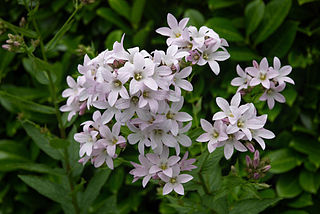
Campanula lactiflora, the milky bellflower, is a species of flowering plant in the genus Campanula of the family Campanulaceae, native to Turkey and the Caucasus. It is a medium-sized herbaceous perennial growing to 1.2 m, with narrow, toothed leaves 5–12 cm (2–5 in) long. Large conical clusters of open, star-shaped flowers are produced on branching stems in summer. In favourable conditions it will self-seed with variable results. The flowers are usually white or pale blue, but numerous cultivars have been developed for garden use, in a range of colours.
